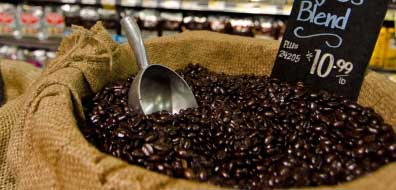From Bean to Cup—The Coffee Making Process

Have you ever wondered how your cup of coffee is made? Where the beans come from? Who picked them? How it’s processed? High up in a lush valley filled with coffee trees, the coffee picker starts his daily routine of picking deep red coffee cherries. From then on, these little cherries go through a series of processes to become what you see in your cup.
At the Nursery
The coffee bean is actually a seed. Some of these seeds become ground coffee, while some of them are replanted to grow more coffee trees. These seeds are planted in shaded nurseries, on large beds of soil. When they enter into a seedling stage, they are then removed from the seed bed and planted into individual pots, which have formulated soils. Coffee seedlings need to be shaded from harsh sunlight and watered regularly.
Coffee Cherries
Coffee trees will begin to bear fruit between 3 to 4 years, and the fruit is called coffee cherry. When ripe, the cherries are bright deep red, and they are then ready to be harvested. Picking the cherries is normally done by hand, and this is a labor-intensive process. Places like Brazil often use machines to do the picking, as the landscape is flat. Coffee cherries are harvested in two ways: either by strip pickings, or selective pickings.
Processing the Cherries
Once the cherries have been picked, coffee is often processed in two ways:
- Dry Method
This method is an old-age method and is still used in many countries, especially where water is a limited resource. The picked cherries are spread out on huge surfaces to allow them to sun-dry. The cherries are then raked and turned throughout the day to avoid spoilage. At night, they are covered to prevent them from getting wet in the rain. This process takes several weeks and until the moisture content drops to 11 percent. The cherries are then taken to the warehouse to be stored.
- Wet Method
After the cherry has been harvested, the pulp is removed via a pulping machine, and the bean is dried with only its parchment skin on. The pulp is normally turned into mulch. After this, the beans pass through a conveyor belt and are separated by weight through water channels. Lighter beans float to the top, while the heavier ones sink to the bottom. After weight, they are separated by size via a series of rotating drums. The beans are then kept in water-filled fermentation tanks for 12 to 48 hours. This is done to remove the layer of mucilage. Once the fermentation is complete, the beans are then rinsed again and are sent for drying.
Drying of the Beans
Both wet and dry methods of the beans need to be sun-dried until only 11 percent of moisture remains. They are then prepared for storage. Beans are dried on drying tables, or on floors, and turned regularly. Once the beans are well dried, they are called parchment coffee and placed in jute bags until they are ready for export.
Milling the Beans
Parchment coffee is a process that starts with hulling, polishing, grading, and—finally—sorting. Hulling removes the parchment layer in wet processed coffee and the dried husk in dry processed coffee. Polishing removes any silver skin that remains on the beans. The beans are then graded and sourced through a pneumatic system that separates the heavy beans from the ripe ones. Any defective beans are removed via sophisticated machines, or by hand, through a conveyor belt. In many countries, both sorting methods are used, so that only superior beans of the finest quality are exported.
Time for Exporting
Beans that are ready for export are milled beans, often called green coffee. These beans are contained in jute bags or sisal bags. Approximately seven million tons of green coffee is produced annually worldwide.
Time to Taste
Testing is done for check for the beans’ quality and taste, and this process is called cupping. The taster, also called the cupper, evaluates the beans for their visual quality. The beans are then roasted in a lab roaster, ground, and infused with boiling water. The aroma of the brewed coffee is also inspected, and, finally, after letting the coffee rest for a few minutes, the taster breaks the crust that is formed at the top of the cup, and the aroma is sniffed again. Testing the coffee starts with a quick slurp—this is to evenly distribute the coffee on the taster’s taste buds. Varieties of coffee and their batches are tasted daily to check for flaws and to determine the best blend to get the perfect roast.

No Comment